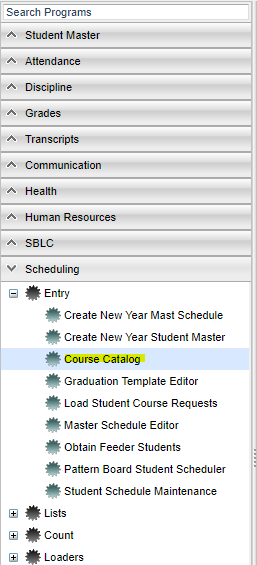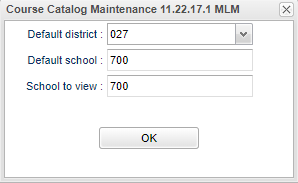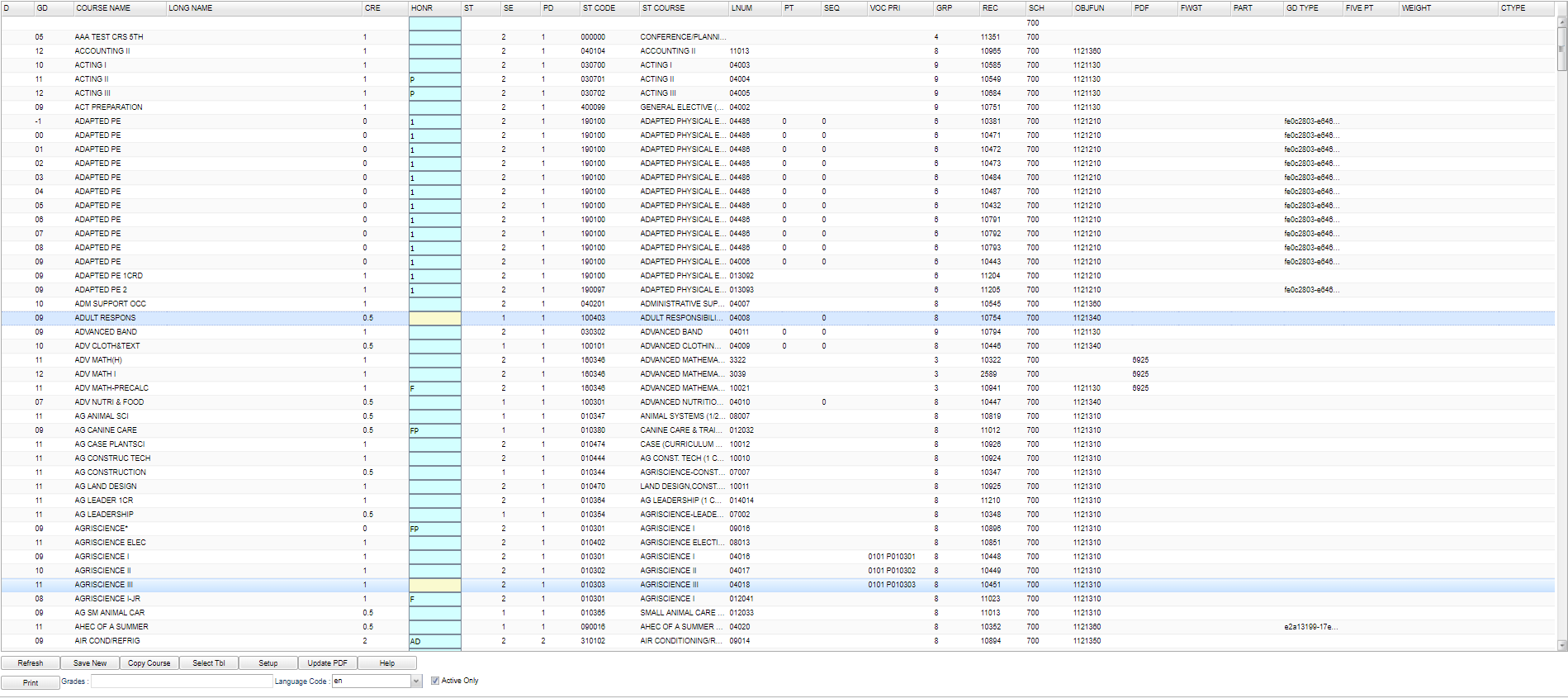Difference between revisions of "Course Catalog"
From EDgearWiki
Jump to navigationJump to search| Line 5: | Line 5: | ||
[[File:course catalog menu.png]] Click on '''Scheduling''', under '''Entry''', select '''Course Catalog'''. | [[File:course catalog menu.png]] Click on '''Scheduling''', under '''Entry''', select '''Course Catalog'''. | ||
| + | |||
==Setup Options== | ==Setup Options== | ||
Revision as of 04:19, 10 January 2018
Video
Menu Location
 Click on Scheduling, under Entry, select Course Catalog.
Click on Scheduling, under Entry, select Course Catalog.
Setup Options
 To find definitions for standard setup values, follow this link: Standard Setup Options.
To find definitions for standard setup values, follow this link: Standard Setup Options.
- Verify that the "District" is correct
- Default School should be set to the school that course will be created for
- School to view will display the courses associated with the school selected
- Click Ok
Main
Column Headers
To find definitions of commonly used column headers, follow this link: Common Column Headers.
- After clicking "Ok", a list of courses should appear on the screen.
- To create a new course, at the top of the list of courses is a blank row. Begin by clicking in the blank cell underneath the header GD. A list of grade levels will appear. Select the appropriate grade level for the course being created.
- Click in the next empty cell under the header labeled COURSE NAME. A box will appear with an area to type the name of the course. Staying within a sixteen character limit, including spaces, type the name of the course.
- Course names need to be unique. Verify that the course being created does not already exist. If not seen in the active course catalog, check obsolete courses by unchecking the Active Only at the bottom of the screen. If it does exist but is not exactly right, DO NOT CHANGE OR DELETE existing courses, CREATE A NEW COURSE. If the course that already exists is not being used anymore, in the "HONR" field, select "O" for obsolete. If the course is still being used, leave it alone and when typing the name of the new course, be sure the name is UNIQUE.
- Symbols - There are symbols that can be added to the course name title
- ! - triggers the course to use alpha grades regardless of what the Pupil Progression Plan states.
- * has no significance at all but is used by a specific district so disregard.
- ^ denoted courses taught below grade level
- Click in the next empty cell under the header labeled CRE. A box will appear listing available credit value options. Select the appropriate credit value for the course being created.
- Click in the next empty cell under the header labeled HONR. A box will appear with a list of codes to define the course. Select all the codes that apply to the course being created. For example a "W" means the GPA will be weighted at 5.0
- Click in the next empty cell under the header labeled ST. "ST" means that the course is a standard course for the grade level selected. Select the "*" for standard for all students, the "F" for standard for all females, or "M" for standard for all males.
- NOTE: The "ST" field is not a required field. It only needs to be entered if the mass request loader is going to be used within the "Load Student Course Requests" program.
- Click in the next empty cell under the header labeled SE. A box will appear listing the possible number of semesters the course could last. Select the appropriate number of semesters the course will last.
- NOTE: Six and nine week school systems should only use 1 and 2 semesters. Only 4x4 school systems have the option to use semesters 3 and 4.
- Click in the next empty cell under the header labeled PD. "PD" means that the length of the course lasts the length of the number of standard class periods entered into this field. Select the appropriate number of periods. Standard is 1.
- Click in the next empty cell under the header labeled ST CODE. A list of state course codes will appear. Select the correct state course code that applies to the course being created.
- After selecting the state course code, a box will appear asking to overwrite the existing course name with the state description. Click NO unless the state course name is preferred.
- The field ST COURSE will be populated after "ST COURSE" is selected.
- NOTE: Please verify that the correct state course code is selected. There are state course codes that are for private schools only, locally initiated programs, and grade level specific. BE ABSOLUTELY SURE OF THE STATE COURSE CODE SELECTED.
- The field LNUM means "Local Number" and is not a required field. The field is used for districts who have local numeric descriptions of courses. To enter a number, click in the empty cell under the header "LNUM". In the box that appears on the screen, enter a six digit number then click "Save".
- The field PT means priority. Courses can be given a priority number that will cause the automatic scheduler to schedule those courses in order of priority. The higher the priority number the earlier the auto scheduler schedules the course. This field is not required.
- The field SEQ means sequential. By giving two course sequential codes, such as 101 and 102, the auto scheduler knows that, if both courses are requested, the course with 101 should be scheduled in the first semester and the course with the code 102 should be scheduled in the second semester. To sequence the next set of courses, skip the next number in the sequence, in this case 103, and start with the next number set, 104 and 105. This field is not required.
- The field VOC PRI stands for vocational priority. Click in the blank field below the header to get a list of vocational clusters. If the course being created is a vocational course, select the appropriate vocational cluster.
- Click in the blank cell below the header labeled as GRP and select the best general description of the course.
- The field REC is a field populated by the system and cannot be changed by the user.
- The field SCH should be populated with the default school selected on the setup box.
- Click in the blank cell below the header OBJFUN to select the default object/function code to be associated with the course.
- NOTE: Object/function is a numerical job description the state uses. The object code, the first three numbers, is the type of job, e.g. supervisor, teacher, aide, etc. The function code, the last four numbers, is the description of the job, e.g. supervisor of child welfare and attendance and teacher of secondary education.
- The field PDF will be populated with a number after the course has been created, the button Update PDF is pushed, and the course is associated with Curriculum Units and GLEs. If a number is displayed, then teachers will be able to select Curriculum Units and GLEs when creating assignments and lesson plans.
- If the course being created is an EOC course, then click in the blank field below the header FWGT. Select the weight value that will be associated with the EOC course. To Remove a Weight select 0.0 as the weight and save. Refresh the screen and the FWGT field will be blank.
- The Part field is for any course that is typically taken for a full credit, but is being scheduled for only one semester but not in the semester in which it is typically scheduled. For example, a first semester (part 1) is being scheduled in the second semester with the check mark in the S2 column check box. This is usually for students who have failed a particular semester and must retake that semester. The retake does not have to be in the same school year.
- GD TYPE provides a list of custom grading scales created in the Sponsor Site Editor on the Grading Scale tab using the Grading Scales Manager under the Action drop down. When a custom grading scale is selected, all sections assigned to that course for the school assigned in the Course Catalog will use that grading scale. If school 700 is assigned, all schools in the district using the course will use the assigned grading scale. When selecting the grade type and using the grade scale database for the listing, if more than one grade type is selected, one and only one of the selections must have the semester final option selected as "Y". If only one grade type is selected, the final semester does not have to be selected. When teachers are creating assignments, the selected grading scale will be the only option.
- The FIVE PT is for 'Display Only' (adjustments cannot be made in this column) indicating that the state uses the five point grading scale for this course for STS purposes. This will not affect your GPAs in your calculations unless you have a "W' in the Honors column of the Course Catalog.
- WEIGHT provides a list of custom marking period weights created in the Sponsor Site Editor on the Grading Scale tab using the Course Weights Manager under the Action drop down. When a custom marking period weight is selected, all sections assigned to that course for the school school assigned in the Course Catalog will use those weights. If school 700 is assigned, all schools in the district using the course will use the assigned marking period weights.
- After all fields have been populated correctly, click the Save New button at the bottom of the screen.
- If the grade level selected for the course being created is -1 to 08, then after clicking Save New, a box will appear listing other grade levels between -1 and 08. If this course is needed for other grade levels as well, select those grade levels from the selection box and click Ok. If the course is not needed in other grade levels, simply click Ok.
Bottom
- Refresh-- button to view any newly created messages.
- Save New--save any information added.
- Copy Course--will copy course for another grade
- Select Tbl--select the whole table.
- Setup--to find definitions for standard setup values, follow this link: Standard Setup Options.
- Update PDF--Obselete
Print Options
To find the print instructions, follow this link: Standard Print Options.
